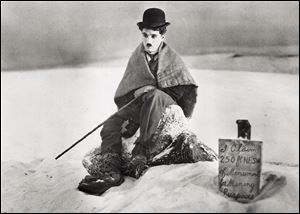
A new release of Charlie Chaplin's classic, 'The Gold Rush'
1925's The Gold Rush one of best legend ever made
7/26/2012
Legendary silent film actor-director Charlie Chaplin is shown in a scene from the 1925 film ‘The Gold Rush.’
The histories of literature and classical music contain many examples of artists going back years later and tampering with and diminishing their earlier work. But the history of movies has only this rather remarkable example:
In 1925, Charlie Chaplin released The Gold Rush, his best film to date and one of the best he would ever make -- or anyone would ever make. Seventeen years later, wanting to rerelease the film, but finding himself in an era in which silent films had no audience, he eliminated the intertitles, made cuts in the story, changed the ending, and added his own voice-over narration. In this version, he spoke the characters' dialogue and added colorful commentary in his own booming, affected, and ostentatious style. The 1942 version was a big hit. But years later, we recognize it for what it is -- a bastardization, a corruption, a destruction, and a disaster.
In 1984, I was in college and figured out a way to borrow 16-millimeter films from the state's film collection, which I did, not because I had any desire to become a critic but because I wanted to see the movies. Without knowing what I was getting, I ordered The Gold Rush and could not believe how awful and intrusive Chaplin's narration was. I had to turn off the sound and slap together my own soundtrack (from various recordings) just to stand watching it.
What I didn't know then is that this bastardized, ruined The Gold Rush was the only version of the film available at the time. The problem was that Chaplin approved the 1942 version -- he considered that the finished film -- and the Chaplin family was honoring his wishes. Moreover, Chaplin had been so negligent about preserving the 1925 version that when Kevin Brownlow and David Gill set about restoring the original in 1993, they had difficulty knowing where to begin.
What we've seen in the past 20 years is a gradual thawing on the part of the Chaplin family with regard to the 1925 version. They allowed it to appear as a special feature in an earlier DVD, and now, in this latest release from Criterion (available on DVD and Blu-ray), it exists side by side with the 1942 abomination. Yet so sensitive does this issue remain that Brownlow and Chaplin biographer Jeffrey Vance, appearing in a short film included on the set, speak quite gingerly of the 1942 version. They feel constrained, I'm sure by necessity, to go along with the fantasy that both versions are of equal merit, when of course they know -- they're too smart not to know -- that the 1942 version is heading toward ignominy, albeit in very slow motion. The 1925 version is the only true version.
If you want to see The Gold Rush -- and you either want to see it and know it, or you want to see it and don't know it -- this is the best opportunity since 1925. In addition to both versions, the new release includes short films about the making of The Gold Rush, including special-effects specialist Craig Barron's insightful explanation of the various techniques used in the film.